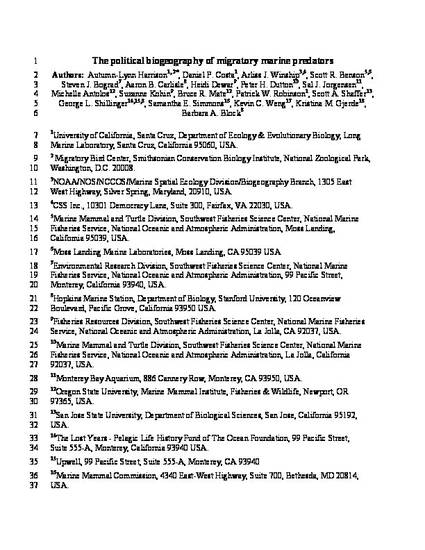
Article
The political biogeography of migratory marine predators
Nature Ecology & Evolution
(2018)
Abstract
During their migrations, marine predators experience varying levels of protection and face many threats as they travel through multiple countries’ jurisdictions and across ocean basins. Some populations are declining rapidly. Contributing to such declines is a failure of some international agreements to ensure effective cooperation by the stakeholders responsible for managing species throughout their ranges, including in the high seas, a global commons. Here we use biologging data from marine predators to provide quantitative measures with great potential to inform local, national and international management efforts in the Pacific Ocean. We synthesized a large tracking data set to show how the movements and migratory phenology of 1,648 individuals representing 14 species—from leatherback turtles to white sharks—relate to the geopolitical boundaries of the Pacific Ocean throughout species’ annual cycles. Cumulatively, these species visited 86% of Pacific Ocean countries and some spent three-quarters of their annual cycles in the high seas. With our results, we offer answers to questions posed when designing international strategies for managing migratory species.
Disciplines
Publication Date
2018
DOI
10.1038/s41559-018-0646-8
Publisher Statement
This is the Preprint of an article published in Nature Ecology & Evolution, volume 2, pages 1571–1578 (2018). The Version of Record is available at this link: https://doi.org/10.1038/s41559-018-0646-8.
SJSU users: use the following link to login and access the article via SJSU databases.
Citation Information
Autumn-Lynn Harrison, Daniel P. Costa, Arliss J. Winship, Scott R. Benson, et al.. "The political biogeography of migratory marine predators" Nature Ecology & Evolution Vol. 2 (2018) p. 1571 - 1578 ISSN: 2397-334X Available at: http://works.bepress.com/scott_shaffer/79/
